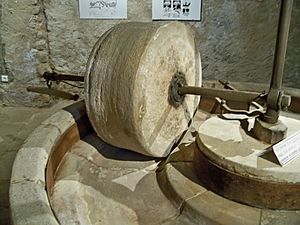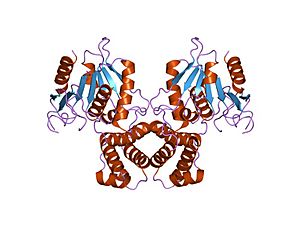Olive oil acidity facts for kids
Free acidity is a super important measurement that tells us about the quality of olive oil. Think of it like a report card for the oil! It's measured as a percentage, showing how many grams of "free" fatty acids are in 100 grams of oil. The main fatty acid in olive oil is called oleic acid.
According to rules set by the European Commission, the very best olive oil, called extra-virgin olive oil, must have a free acidity lower than 0.8%. Virgin olive oil has an acidity between 0.8% and 2%. If the free acidity is higher than 2%, it's called lampante olive oil. This type of oil is not good enough to eat on its own.
Why does free acidity go up? It happens when free fatty acids break away from larger molecules called triglycerides in the oil.
Contents
How Free Fatty Acids Form
Free fatty acids appear in olive oil because of a process called lipolysis. This process starts when special enzymes, which are usually found in the pulp and seeds of the olive, mix with the oil. This happens if the olive fruit gets damaged.
High free acidity in olive oil can be caused by several things:
- Using unhealthy olives, perhaps from microorganisms, moulds, or insect attacks.
- Olives that have been bruised.
- Waiting too long to harvest the olives or storing them for too long before making oil.
The lipolysis reaction speeds up a lot when water is present. So, when the oil is separated from water during processing, this reaction slows down and eventually stops. This is why it's important to separate oil and water quickly!
Measuring Free Acidity
Free acidity is a problem for olive oil, but you can't taste or smell it. So, you can't tell if oil has high acidity just by trying it. Also, since vegetable oils are not watery liquids, you can't use a regular pH-meter to measure their acidity. Luckily, there are different ways to measure oil acidity very accurately.
Manual Titration
The official way to measure free acidity in olive oil is a manual process called titration. This is how it works:
- A known amount of the oil is mixed with chemicals like ether, methanol, and phenolphthalein.
- Then, small amounts of a special liquid called potassium hydroxide (KOH 0.1M) are slowly added. This liquid is called the "titrant."
- The titrant is added until the color of the mixture changes.
- The total amount of titrant used tells us the free acidity.
This official method is very accurate and reliable. However, it's a lab method that needs trained people to do it, mainly because some of the chemicals used are toxic. This means it's not easy to do right at a small oil mill.
Near-Infrared Spectroscopy
Another promising way to measure acidity uses light, specifically near-infrared spectroscopy (NIR). This method looks at how much light the oil sample absorbs.
- An oil sample is put into a small container called a cuvette.
- A spectrophotometer then shines light through it across many different wavelengths.
- The results (how much light was absorbed at each wavelength) are then analyzed by a computer program using special math, like Principal Component Analysis (PCA) or Partial Least Squares regression (PLS). This helps estimate the oil's acidity.
Scientists have shown that NIR spectroscopy can measure free acidity and other qualities in olive oil. Many commercial spectrophotometers exist that can do this. The big advantage of NIR spectroscopy is that you can test the raw olive oil without any chemical preparation. The downsides are that the machines can be expensive, and they need to be set up (calibrated) for different types of oil, depending on the olive variety or where they came from.
Electrochemical Impedance Spectroscopy
A different method uses something called electrochemical impedance spectroscopy (EIS). EIS is a powerful technique used to study many different food products. For example, it has been used to:



